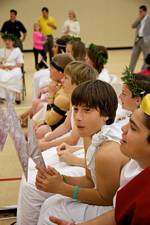-
WALK THROUGH THE ANCIENT WORLD - STANDARDS
 Walk Through the Ancient World is specifically designed to involve students in the California Arts Standards for Theatre, English Language Arts, and History-Social Science Standards – emphasis on Ancient Egypt, Greece and Rome. Presenters lead students in activities that help them become actively involved in learning about history, as well as foster teamwork, dramatic performance, recall, and critical thinking. Activities include role playing, cooperative games, and a summary and review of important events and people.6.2 Students analyze the geographic, political, economic, religious, and social structures of the early civilizations of Mesopotamia, Egypt, and Kush.
Walk Through the Ancient World is specifically designed to involve students in the California Arts Standards for Theatre, English Language Arts, and History-Social Science Standards – emphasis on Ancient Egypt, Greece and Rome. Presenters lead students in activities that help them become actively involved in learning about history, as well as foster teamwork, dramatic performance, recall, and critical thinking. Activities include role playing, cooperative games, and a summary and review of important events and people.6.2 Students analyze the geographic, political, economic, religious, and social structures of the early civilizations of Mesopotamia, Egypt, and Kush.State of California English Language Arts Standards for Public Schools
State of California Arts Standards for Theater in Public Schools
State of California History-Social Science Content Standards for Public Schools
6.2.1 Locate and describe the major river systems and discuss the physical settings that supported permanent settlement and early civilizations.
6.2.3 Understand the relationship between religion and the social and political order in Mesopotamia and Egypt.
6.2.5 Discuss the main features of Egyptian art and architecture.
6.2.6 Describe the role of Egyptian trade in the eastern Mediterranean and Nile valley.
6.2.7 Understand the significance of Queen Hatshepsut and Ramses the Great.
6.4 Students analyze the geographic, political, economic, religious, and social structures of the early civilizations of Ancient Greece.
6.4.1 Discuss the connections between geography and the development of city-states in the region of the Aegean Sea, including patterns of trade and commerce among Greek city-states and within the wider Mediterranean region.
6.4.4 Explain the significance of Greek mythology to the everyday life of people in the region and how Greek literature continues to permeate our literature and language today, drawing from Greek mythology and epics, such as Homer’s Iliad and Odyssey, and from Aesop’s Fables.
6.4.6 Compare and contrast life in Athens and Sparta, with emphasis on their roles in the Persian and Peloponnesian Wars.
6.4.7 Trace the rise of Alexander the Great and the spread of Greek culture eastward and into Egypt.
6.4.8 Describe the enduring contributions of important Greek figures in the arts and sciences (e.g., Hypatia, Socrates, Plato, Aristotle, Euclid, Thucydides).
6.7 Students analyze the geographic, political, economic, religious, and social structures during the development of Rome.
6.7.1 Identify the location and describe the rise of the Roman Republic, including the importance of such mythical and historical figures as Aeneas, Romulus and Remus, Cincinnatus, Julius Caesar, and Cicero.
6.7.2 Describe the government of the Roman Republic and its significance (e.g., written constitution and tripartite government, checks and balances, civic duty).
6.7.3 Identify the location of and the political and geographic reasons for the growth of Roman territories and expansion of the empire, including how the empire fostered economic growth through the use of currency and trade routes.
6.7.4 Discuss the influence of Julius Caesar and Augustus in Rome’s transition from republic to empire.
6.7.6 Note the origins of Christianity in the Jewish Messianic prophecies, the life and teachings of Jesus of Nazareth as described in the New Testament, and the contribution of St. Paul the Apostle to the definition and spread of Christian beliefs (e.g., belief in the Trinity, resurrection, salvation).
6.7.7 Describe the circumstances that led to the spread of Christianity in Europe and other Roman territories.
6.7.8 Discuss the legacies of Roman art and architecture, technology and science, literature, language, and law.
- Presentations
-
Teachers
CALIFORNIAAMERICAN REVOLUTIONANCIENT WORLDOTHER RESOURCES
- Students/Parents
- Reservations
- Photos
-
About
ABOUT CALIFORNIA WEEKLYIN THE PRESS
- Contact Us
- Presentations
- -- What is a Walk Through?
- -- Walk Through California
- -- Walk Through American Revolution
- -- Walk Through Ancient World
- Teachers
- -- CALIFORNIA
- ---- Overview
- ---- Class Activities
- ---- Preparation Tips
- ---- Costumes
- ---- State Standards
- ---- Photos
- ---- Walk Through California Teacher Preparation Guides
- -- AMERICAN REVOLUTION
- ---- Overview
- ---- Class Activities
- ---- Preparation Tips
- ---- Costumes
- ---- State Standards
- ---- Photos
- ---- Walk Through the American Revolution Teacher Preparation Guides
- -- ANCIENT WORLD
- ---- Overview
- ---- Class Activities
- ---- Preparation Tips
- ---- Costumes
- ---- State Standards
- ---- Photos
- ---- Walk Through the Ancient World Teacher Preparation Guides
- -- OTHER RESOURCES
- ---- Teachers FAQs
- ---- Useful Forms/Templates
- ---- Photo Gallery
- Students/Parents
- -- CALIFORNIA
- ---- Overview
- ---- Historical Attire
- ---- California Expert Card
- ---- More Information About California
- ---- California Rancho Information
- ---- Photos
- -- AMERICAN REVOLUTION
- ---- Overview
- ---- Historical Attire
- ---- American Revolution Student Cards
- ---- More Information About American History
- ---- Photos
- -- ANCIENT WORLD
- ---- Overview
- ---- Historical Attire
- ---- Ancient World Student Cards
- ---- More Information About Ancient World
- ---- Photos
- -- OTHER RESOURCES
- ---- Memorization And Acting Tips
- ---- Parent FAQs
- ---- Parent Helper Information
- Reservations
- -- Make a Reservation/Fill in Reservation Itinerary Details
- -- FAQs
- -- Pricing Information
- Photos
- -- California
- -- American Revolution
- -- Ancient World
- About
- -- ABOUT CALIFORNIA WEEKLY
- ---- History of California Weekly
- ---- Employment Opportunities
- ---- Our Presenters
- -- IN THE PRESS
- ---- Fan Mail
- ---- Reviews
- ---- In The News
- Contact Us

